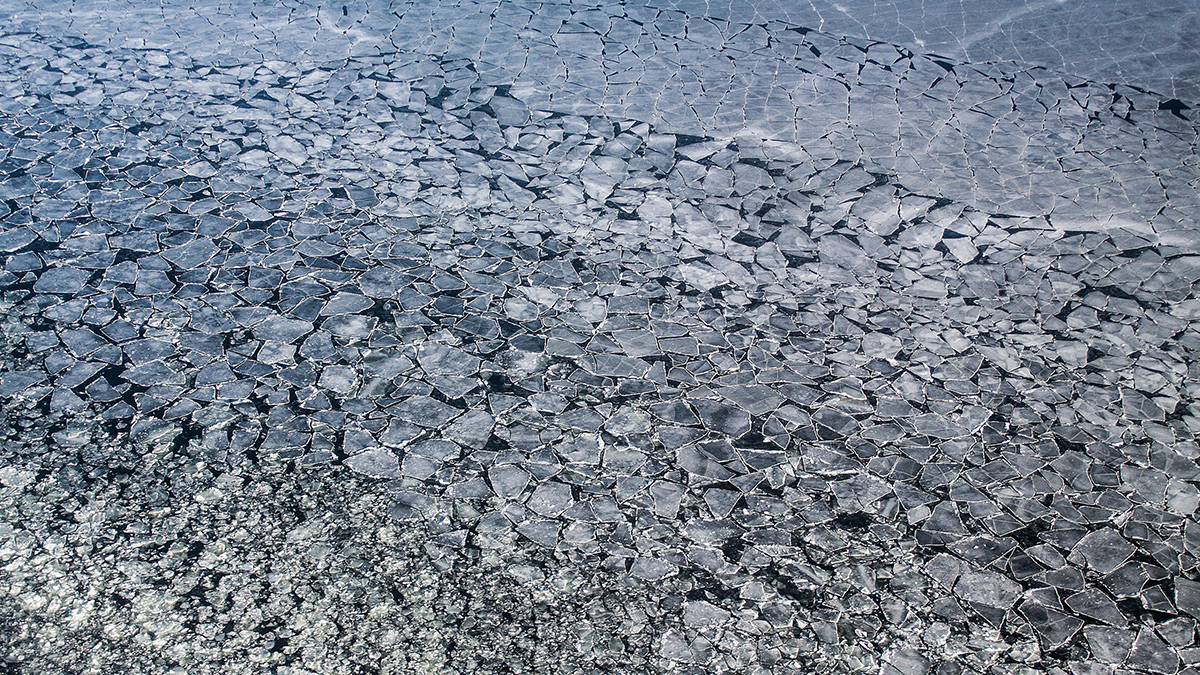Even at freezing temperatures, sea ice can transport heat between the ocean and the atmosphere, a process that affects climate. The salty fluids trapped inside sea ice play a much larger role at warmer temperatures than thought, according to new mathematical modeling.
The work could be used to update global climate simulations with more accurate estimates of how much heat moves from the air to the ocean in polar regions, said Noa Kraitzman, a mathematician at Macquarie University in Sydney, Australia, who worked on the project. That, in turn, could improve our simulations of how the climate will evolve in coming years, especially at the poles, which are warming faster than other places.
“It’s super, super important, especially for global climate models, to actually get the physics behind processes in sea ice correct.”
The update builds on decades of research that has gradually unveiled the intricacies of sea ice, giving researchers more insights into what goes on just beneath the surface. As warming waters drive a shift toward younger and more dynamic sea ice, these new insights will likely be more important than ever.
“It’s super, super important, especially for global climate models, to actually get the physics behind processes in sea ice correct,” Kraitzman said. How, exactly, their modeling will change what climate models show remains to be seen, however.
No Simple Ice
From the perspective of a climate modeler, sea ice is a very thin layer that separates the atmosphere from the ocean, mediating heat exchange between them.
“We can think of the thermal conductivity of the ice almost like being the gas pedal” for temperature changes, said Don Perovich, a sea ice geophysicist at Dartmouth College in Hanover, N.H., who wasn’t involved in the research.
Ocean temperatures stay relatively constant, while the atmosphere in polar regions swings between above and far below freezing throughout the seasons. This means heat flows back and forth between the two, with sea ice in the middle.
For many years, Kraitzman said, the speed at which sea ice transmitted heat was simply taken to be a constant in climate models. More recent research has shown that that’s anything but true.
“Sea ice is a very complex material,” she said. “It’s not simple ice.”
Three main ice ingredients affect how heat moves through sea ice: the pure water ice itself, air bubbles, and pockets of briny seawater. The relative ratios of these parts, how they are arranged, the temperature, and more can affect how heat moves through the ice, making accurate estimates “quite nontrivial,” according to the study’s authors.
Researchers have been getting closer to more accurately representing this complexity, first by adding in changes to thermal conductivity due to temperature changes, and then by estimating how fluid flows in the ice carry heat. Now, using a mathematical technique that considers sea ice and its constituent parts as a uniform material, Kraitzman and her coauthors have derived the best estimate yet of how sea ice transports heat.
When temperatures get to around −5°C (23°F), briny water begins to melt and move. The new work simulates this flow of salty seawater through the ice, which the researchers accomplished by adding periodic flows and homogenizing them, Kraitzman said.
Adding in this crucial component turned out to make a big difference, Kraitzman said. Previous work showed that thermal conductivity in sea ice decreased as temperatures went up—the new model shows it’s actually the opposite. What’s more, the increase in conductivity is significant: potentially up to 2 or 3 times as much. These results were published in the Proceedings of the Royal Society A.
The new numbers could bring existing climate models more in line with reality.
“This shouldn’t surprise us, because as we’re going into warmer summers, we see that our models do not predict correctly what’s going to happen to sea ice,” Kraitzman said.
The Future of Ice
The group’s research comes at a pivotal moment. As the planet warms and more sea ice melts in the summer, a larger proportion of winter sea ice is first-year ice, which hasn’t yet fully solidified, Perovich said. On the bottom there is a “mushy layer” made of warmer ice and brine that affects how the ice behaves. One big takeaway from the research is that thermal conductivity doesn’t change much when sea ice is cold but begins to do so as temperatures warm to near freezing. The movement of brines in the ice plays a big role in that.
“There were these periods where their modeling showed that you can have significant increases in thermal conductivity,” Perovich said.
The next step is to add the new bounds for thermal transport into the large, coupled climate models researchers use to forecast how the environment will change in coming years and decades. It’s not clear yet how exactly a modeled increase in heat transport will affect the climate, Kraitzman said.
“The mathematics, in a way, is saying, ‘Oh, here’s something interesting. Let’s go study it.’”
“Because we’re changing the entire heat flux in this way, then it might allow sea ice to melt faster or to stay for longer,” she said.
Also important will be taking new measurements of heat transport in natural sea ice, Perovich said. The most recent data are almost 20 years old, and both technology and the sea ice itself have changed in that time.
“The mathematics, in a way, is saying, ‘Oh, here’s something interesting. Let’s go study it,’” he said.
Kraitzman said their work is not yet fully finished, either. Their model didn’t fully capture how water moves into and out of the ice, or the effects of tiny organisms in the ice. Sea ice has complexities yet to unravel.
—Nathaniel Scharping (@nathanielscharp), Science Writer

